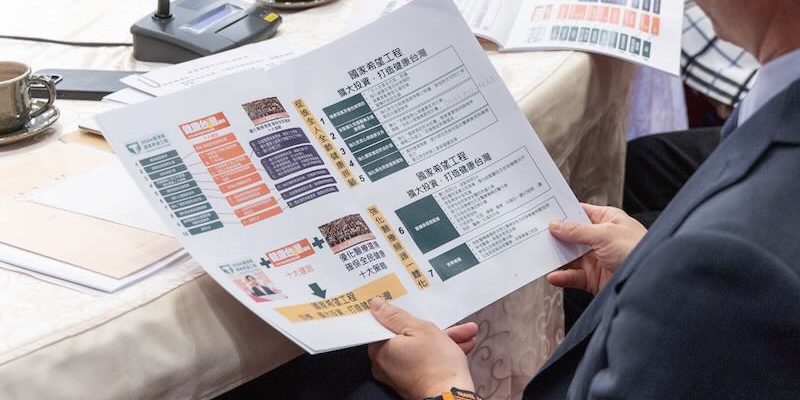
Some of Taiwan’s many natural wonders are better known than others. For visitors from all over the world, the splendor of Taroko Gorge and the stunning variety of the island’s birdlife are like magnets.
The Purple Butterfly Valley in Maolin, a mountainous part of Kaohsiung about 250 km down island from Taipei, is unique but not so well known. Sometimes compared to the famous colonies of monarch butterflies that appear each winter in Mexico, it features not just one migrating lepidopteran species, but four.

Dwarf Crow butterflies account for the majority of Maolin’s guests. Most of the others are Striped Blue Crows or Double-branded Black Crows, while around one in fifty is a Blue-banded King Crow. The wings of all four species boast patches of blue and purple.

Between October and March, these alluring creatures congregate in such numbers that an individual tree may host more than a thousand butterflies. If you are in the right place at the right time, you may see a “butterfly waterfall” as tens of thousands of delicate wings flutter en masse toward the base of this pristine valley. To grasp just how crowded Maolin’s airspace can get, check out some of the short videos shared in the “Latest Butterfly Info” section of the Maolin National Scenic Area’s website (www.maolin-nsa.gov.tw).
Even if it lacked butterflies, Maolin would deserve a place on any in-depth itinerary. It is an idyllic place for camping, hiking, and birdwatching. And unlike most of Taiwan, which is dominated by people of Han Chinese descent, almost all of the inhabitants of Maolin are members of the indigenous Rukai tribe.
The 13,700-strong Rukai, sometimes known as the Drekay, are one of Taiwan’s smaller ethnic groups. Despite integration into the mainstream economy and Taiwan’s democracy, their society continues to recognize hereditary chiefs and noble families, each social class having distinct rights and obligations. After decades of decline, the Rukai language is now taught in local schools. Like all of Taiwan’s indigenous Austronesian tongues, it is unrelated to Mandarin and other Sinitic languages.
In the middle of July each year, the Rukai inhabitants of Duona in Maolin celebrate the Black Rice Festival, which they call the Tapakadrawane. The festival expresses the community’s gratitude to their gods for a successful harvest. They ask the deities to both welcome outsiders and ensure there is sufficient rainfall during the subsequent cropping season. Surrounded by mountains and blessed with charming gray slate dwellings, Duona is worth visiting at any time of year.

Even more remote is the National Wanshan Rock Carvings Archaeological Site. With the exception of research expeditions led by indigenous guides, few people have reached this site and seen the remarkable petroglyphs it preserves — but it is cherished by the Rukai people as a link to their ancestors and the tribe’s history.
If you want to learn about the butterfly migration, the bilingual exhibition inside the Maolin Visitors Center, conveniently located in Maolin’s main village, is a good place to start. Here you can learn about butterflies and their migration through the Maolin area.

Up-to-date information about the butterfly migration, as well as maps and transportation tips, can be found on the national scenic area’s website. The website also has an abundance of information and images about every part of the scenic area, which encompasses not just Maolin but also districts and townships to the north and south where you can enjoy indigenous culture and cuisine, hot springs, waterfalls, woodlands, and rugged landscapes.
If you plan to visit the Maolin area during the Butterfly Appreciation Season, do pay attention to the national scenic area’s website in the days and weeks before you arrive. Each year, the authorities work with local businesses to offer a range of butterfly-themed activities that are designed to entertain and educate. If you are traveling with children, and hope they can gain an appreciation for the wonders of nature and the importance of conservation, these events might be just the ticket.

More and more international visitors are opting for self-driving vacations, but not everyone wants to deal with dense traffic in urban areas and finding parking spots. This is just one reason why, when planning an expedition away from Taiwan’s big cities, it always pays to look at the multilingual website (www.taiwantrip.com.tw) that outlines Taiwan Tourist Shuttle bus services throughout the country.
In the south, consider taking advantage of the Dapeng Bay Liuqiu Route, which connects Kaohsiung’s high-speed railway station with the fishing town of Donggang (where you can catch a boat to the delightful little island of Xiao Liuqiu) and Dapeng Bay, one of Taiwan’s largest lagoons.
Once a base for military seaplanes, the bay is now a venue for various watersports. Yachts can enter and leave the lagoon and its marina thanks to Taiwan’s only folding vehicular bridge. But this sail-shaped, cable-stayed structure might not be the bay’s most photographed feature, as Oyster Shell Island is a highlight of every sightseeing boat tour around the lagoon. This is not a true island, but rather the result of oyster farmers dumping unwanted shells at the same spot, decade after decade. Like a reef, it now attracts and shelters fish.

To amplify the region’s appeal and coordinate government and private-sector resources, the Tourism Bureau recently played midwife to the birth of the Kaohsiung Tourism Union. This destination marketing body integrates the tourism industry in all 38 districts of Kaohsiung, as well as three townships in adjacent Pingtung County. The area encompasses everything that is fascinating about the country, including high mountains, fishing villages, Hakka and indigenous settlements, and farms that grow a dazzling variety of crops.
Other useful sources of information include the Tourism Bureau of Kaohsiung City Government (khh.travel) and the Tourism Bureau’s national website (www.taiwan.net.tw). If you struggle to find an answer to a particular question, call the tourism hotline on 0800-011-765 (toll-free within Taiwan). If they cannot give you the information right away, they will call you back.





